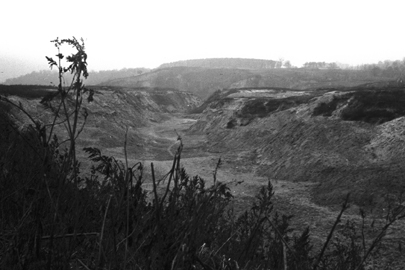Babi Yar symposium looks at facts, memories, depictions
Attendees to examine history, responses to reoccupation, literary representations and symbolic meaning

Photo of Babi Yar courtesy of the Central State CinePhotoPhono Archives of Ukraine.
A young Kiev resident, Ol'ga Anstei – Jewish by her maternal lineage and German on her paternal side – escaped the carnage but remained haunted by the image of the Jewish procession departing the city on that hazy autumn morning.
 |
|
Babi Yar in History and Memory: Seventy Years After a Mass Murder Oct. 5, 2 to 6 p.m., in International Lounge, Usdan Student Center |
 |
The first two cycles of her poem "Kirillovskie iary" (Kirillov Ravines, also known as Babi Yar, 1943), recounts the tender memories of a beautiful dark-complexioned girl with adoring young men at her feet in the wild ravines, "the most carefree of carefree places." But that site of youthful pleasure and freedom quickly becomes a terrifying place (strashnoe mesto), the primal scene of the mass killings.
Where nature quietly celebrated,
Became Golgatha, the foot of the cross,
For an ancient and fated people.
Listen! They lined them up in order.
Their belongings heaped in piles on slabs,
Half-suffocated, half-dead.
Half-interned in the earth. . .
Do you not see those women in shawls?
The old men, majestic like Abraham?
And the curly-haired Bethlehem infants
In their mother's arms?
I have no words for this:
Do you not see--here on the road, plates and dishes,
A torn tallis, fragments of a Talmud,
Pieces of passports soaked by the rain.
A black burnt cross on the forehead.
A most terrible place of terrible places.
Scattered are the symbols of everyday life (plates and dishes), long-forgotten memories of Judaism (a torn tallis, fragments of a Talmud), and remnants of Soviet and Jewish identity (scraps of passports). With a stroke of Anstei's pen, Kievan Jews transfigure into Biblical figures, no longer of this world, but phantoms of the past, full of wisdom, vulnerability, and pain. Like Lamed Shapiro's protagonist who is branded with a cross on his forehead during a vicious pogrom in Der Tseylem (The Cross, 1909), the Babi Yar victims are marked by the emblem of Christian salvation, but it offers them no redemption, wrenching them from civilization to that "most terrible place of terrible places."
Anstei was one of many writers, photographers, and artists to grapple with the cruelty of Babi Yar. The same year that Anstei wrote her poem, the Ukrainian-Jewish Sava Holovanivs'kyi had also penned his devastating poem, "Avraam," in which he lamented the lonely procession of elderly Jews through the streets of Kiev while the local residents looked on indifferently – a critique echoed in another poem by Leonid Pervomaiskii in "In Babi Yar."
After the war, Dmitrii Dmiterko, head of the Ukrainian Writer's Union, responded harshly to the accusation of Ukrainian complicity under the guise of indignation over the sullied honor of the Soviet people: "In this poem, Holovanivs'kyi heaps terrible unthinkable slander upon the Soviet nation. He lies brazenly by alleging that the Soviet people – Russian and Ukrainian – turned their backs on the old Jew Abraham, whom the Germans were marching through the streets of Kiev to be shot. This is a terrible defamation of the Soviet Union, which has succeeded after a hard and bloody struggle, and by dint of great sacrifice and effort, in upholding the freedom and independence of the Soviet people of all nationalities." Efforts to silence charges of collaboration and the notion of a special Jewish suffering led to official rebukes and censorship even before the war had ended.
Far from submitting to a self-imposed or state-instituted wall of silence, individuals poured out their responses to the mass murder in the form of historical documentation, poetry, prose, art, music, and film.Babi Yar became a symbol that held multiple meanings for all Soviet citizens: for the Jews, it meant the reawakening of Jewish identity and collective mourning for the "countless family, kith and kin" in the words of Ilya Ehrenburg. For the Yiddish writer, Peretz Markish, Babi Yar was a place where "the earth heaved for seven days over the mass grave of people buried alive." His poem “Milkhome” (“War”), 1948, signified the unspeakable sufferings of the Jewish people, those who died and those who remained alive. For the Soviet intelligentsia, such as Viktor Nekrasov, Yevgeny Yevtushenko and Anatolii Kuznetsov, Babi Yar came to represent their rejection of antisemitism and protest against Soviet repression of their freedom of expression.
As Yetushenko wrote in his famous 1961 poem "Babi Yar": "Today, I am as old as the entire Jewish race itself. And here upon the cross, I perish, tortured and even now I bear the marks of nails."
Seventy years after a mass murder, a symposium at Brandeis Oct. 5 will explore Babi Yar through different lenses: Babi Yar in history; Soviet responses to Babi Yar after the reoccupation of Kiev by the Red Army, especially in the Yiddish press; the representations of Babi Yar in Jewish literature and its symbolic meaning for the Russian intelligentsia.
Though loss of a beloved relative at Babi Yar may not be part in our personal experience, we might echo the sentiment captured in Ehrenburg's poem published in Novyi mir (1948):
There were no relatives of mine among those who lost
Their lives, but nowhere, I think have I felt so
Wretched, so orphaned, as on the sands of Babi Yar.
Here and there a pile of ashes and charred bones made a
Black patch.
Somehow I had the feeling that my relatives, friends, childhood playmates had perished
Here, friends whom forty years earlier I had watched at
Their games in the murky streets of Podol and Demievka.
---------
ChaeRan Freeze is associate professor of Near Eastern and Judaic Studies and Women's and Gender Studies. Her research focuses on the history and culture of the Jews in Russia, Jewish family history and women’s and gender studies.
Categories: Humanities and Social Sciences, International Affairs






